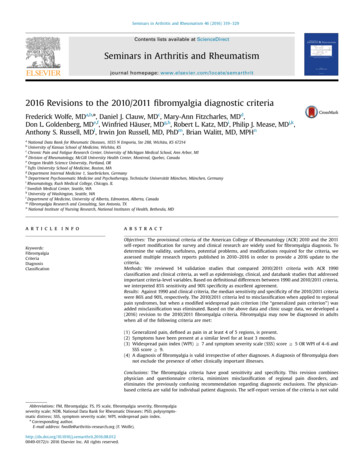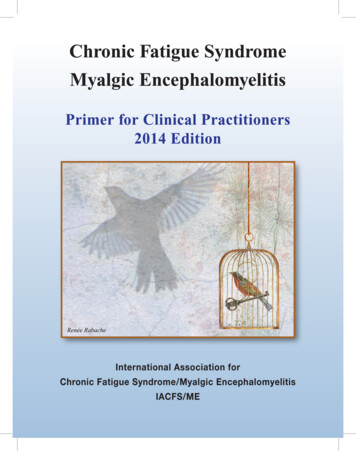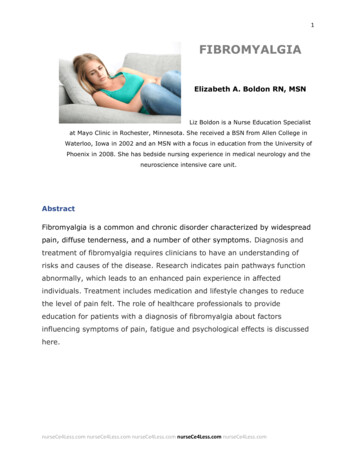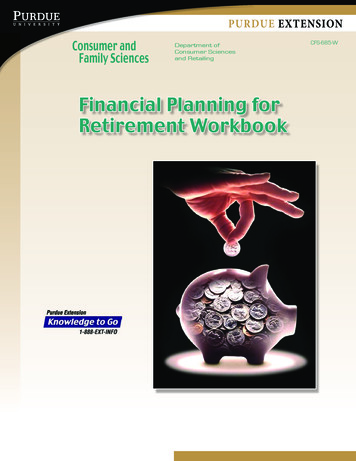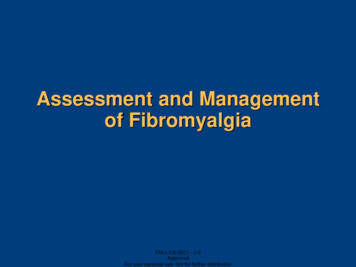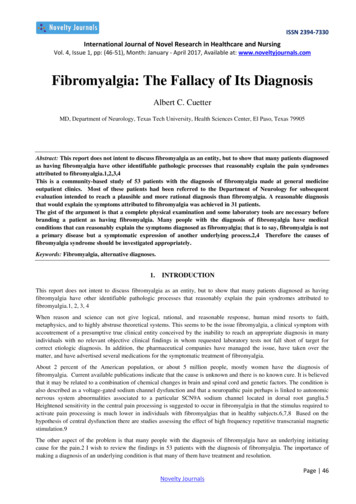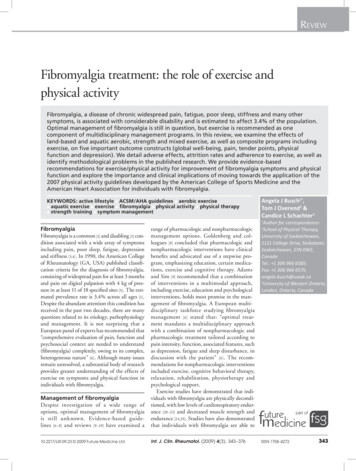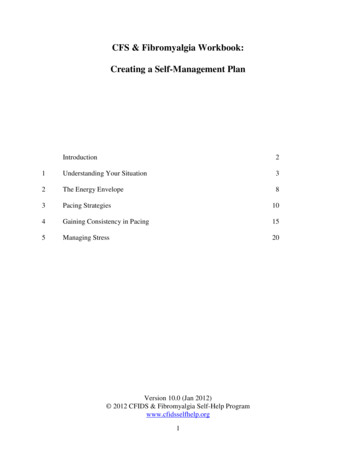
Transcription
CFS & Fibromyalgia Workbook:Creating a Self-Management PlanIntroduction21Understanding Your Situation32The Energy Envelope83Pacing Strategies104Gaining Consistency in Pacing155Managing Stress20Version 10.0 (Jan 2012) 2012 CFIDS & Fibromyalgia Self-Help Programwww.cfidsselfhelp.org1
IntroductionLiving with CFS and/or fibromyalgia can feel overwhelming at times, but there are many thingsyou can do to regain control. This workbook focuses on the area likely to produce the biggestgains: lifestyle change, which means adjusting your habits and how you live your daily life. Thisis a gradual process, changing one or two things at a time, but used consistently it can betransforming.This class focuses on the two areas we believe are the heart of a self-management plan forCFS/FM: pacing and stress management. The next class (Self-Help III: Living Your Plan) offerssupport for integrating pacing and stress management into your life, and also focuses on otherareas, such as treating symptoms, managing emotions, reworking relationships and creating anew life in response to loss.Two disclaimers before we begin. First, this workbook will not make you better. Only you cando that. The workbook will give you the tools for feeling better and the class will offer yousupport, but you have to do the work.Second, learning to live well with a long-term illness requires hard work, determination andpatience. You will probably feel discouraged at times. When that happens, we hope youremember that many people before you have had similar feelings and have gone on to improve,one step at a time. The keys to improvement are a willingness to adapt and consistent use of thetools of self-management, especially pacing and stress management.2
Chapter 1: Understanding Your SituationWhen you develop a long-term condition like Chronic Fatigue Syndrome or fibromyalgia, youmay feel like you have entered a new world in which all the rules of life have changed and thereis no obvious way forward. This perplexing situation can make you feel helpless. But there aremany things you can do to regain control and improve your well being. This workbook will showyou how. Using the ideas you‟ll find here, you can create a plan for managing CFS and/orfibromyalgia.When you first experienced CFS and/or fibromyalgia, you may have thought you had a shortterm illness, but at some point, you were confronted by the fact that your problem was somethingquite different. Rather than a temporary problem, CFS and FM are conditions that persist.Instead of resuming your previous life after a brief interruption, you were faced with having toadjust to long-term symptoms and limitations.CFS and fibromyalgia are different in a second way. Not only do they impose limits and bringsymptoms that persist, they have comprehensive effects, touching many parts of life. They affectyour ability to work, your relationships, your moods, your hopes and dreams for the future, andeven your sense of who you are. Living with a long-term condition like CFS or fibromyalgiameans much more than managing symptoms. A plan for managing them has to address all itseffects.Third (and perhaps most important), Chronic Fatigue Syndrome and fibromyalgia are affected byhow you respond to them. There is so far no cure for either CFS or fibromyalgia, but how yourespond to your situation has a big effect on symptoms and quality of life, often a larger effectthan medical treatments. As Dr. Charles Lapp says, “There are limits to what your doctor cando.” The key to recovery with these conditions, he says, “is acceptance of the illness andadaptation to it by means of lifestyle changes, for which medical treatment is no substitute.”Each person with CFS or FM is different, so your self-management plan should fit your uniquesituation. We begin with exercises to help you understand your individual circumstances.Your CFS/FM (Severity)The severity of CFS and FM varies greatly. Some people‟s lives are touched lightly, while othershave their lives disrupted moderately and still others are housebound or even bedbound. To treatyour illness effectively, you need to understand your version of CFS and/or FM.You can get an overall idea of your CFS or FM by placing yourself on the Rating Scale on thenext page. Place yourself on the scale by answering the question “What is the highest level offunctioning I can sustain without intensifying my symptoms?”3
Your rating gives you an idea of the severity of your illness and of the activity level your bodycan tolerate at present. For example, if you rate yourself at 30 (average for people in ourprogram), your activity level would be about three hours a day.My Self-RatingCFS/Fibromyalgia Rating Scale100Fully recovered. Normal activity level with no symptoms.90Normal activity level with mild symptoms at times.80Near normal activity level with some symptoms.70Able to work full time but with difficulty.symptoms.60Able to do about 6-7 hours of work a day. Mostly mild tomoderate symptoms.50Able to do about 4-5 hours a day of work or similar activity athome. Daily rests required. Symptoms mostly moderate.40Able to leave house every day. Moderate symptoms onaverage. Able to do about 3-4 hours a day of work oractivity like housework, shopping, using computer.30Able to leave house several times a week. Moderate tosevere symptoms much of the time. Able to do about 2hours a day of work at home or activity like housework,shopping, using computer.20Able to leave house once or twice a week. Moderate tosevere symptoms. Able to concentrate for 1 hour or less perday.10Mostly bedridden. Severe symptoms.0Mostly mildBedridden constantly. Unable to care for self.Additional Medical IssuesLiving with CFS or fibromyalgia is often complicated by the presence of additional medicalproblems. Many people have both CFS and FM. Also, CFS and FM are often accompanied byone or more other health issues. Other conditions often found together with CFS and FM includethose listed alphabetically below. In addition, people with CFS and FM often experienceconditions common to aging, such as arthritis, back and spinal problems, and high bloodpressure.4
Chemical sensitivityDepressionFood/digestive issues: Candida (yeast infection), Celiac disease, lactose intoleranceGastroesophageal reflux disease (GERD)Irritable bladder syndrome (interstitial cystitis)Irritable bowel syndrome (IBS)Migraine headachesMyofascial pain syndrome (MPS)Orthostatic problems such as neurally mediated hypotension (NMH) or posturalorthostatic tachycardia syndrome (POTS)ProstatitisRestless legs syndrome (RLS)Sleep apneaTemporomandibular joint disorder (TMJ)Thyroid problemsFill in your medical issues below, rating the severity of each from 1 (mild) to 10 (severe).My Medical IssuesCFSFibromyalgiaSeveritySeverityYour Life SituationJust as people with CFS and fibromyalgia differ in the severity of their medical problems and inthe number of illnesses they have, so do they come from many different life situations. Somepeople with CFS/FM are young; many are middle-aged; some are older. Some are married, whileothers are single. Some are raising children, while others are empty-nesters. Some are insupportive relationships; others in conflicted ones. Some are financially secure, while others arestruggling.Your challenges and the resources you have to deal with them will vary depending on yoursituation, especially your family circumstances (single or married and stage in life), yourfinances, your responsibilities (who is dependent on you: children, parents, spouse,grandchildren or others) and your sources of support (family, friends, church or other religiousgroup, etc.).5
Your situation includes two other significant factors: your coping skills and attitude. The goodnews: these factors can be changed. Research has shown that people can learn effective copingskills for managing long-term illness, either on their own or through self-help classes such as thisone. Attitude is also important to living well with long-term illness. The attitude that seems tohelp is one that is both realistic and hopeful. We call it acceptance with a fighting spirit. Peoplewith this attitude combine recognition that life has changed with a conviction that they can findways to improve.For some examples of the effects of a constructive approach to CFS and FM, see the SuccessStories on our website: http://www.cfidsselfhelp.org/library/topic/Success Stories. For ideas onhow to change your attitude, see the article Optimism, Hope & Control.Your GoalsWhat would you like to accomplish through using this workbook? People give different answersto this question. Here are some of the more common ones. The program is designed to helppeople achieve these goals.1. Reduce my symptoms. One of the challenges of CFS and FM is living with symptoms thatbring ongoing pain, discomfort and suffering. Reducing the intensity of symptoms and the extentof their interference with life is a goal for many people. The workbook will show you how toreduce symptoms by changing how you live. (For Dr. Lapp‟s recommendations on medications,see Treating Symptoms section at the website we developed jointly with him:www.treatcfsfm.org .)2. Regain control of my life. Many people with CFS and FM experience repeated cycles of pushand crash. They swing between periods of activity, which produce higher levels of symptoms,and times of forced rest. The cycle often leads to a feeling of helplessness. The workbook willshow you how to get off this roller coaster and establish a more stable life.3. Learn how to avoid relapses. Relapses are a frequent and often demoralizing experience forpeople with CFS and FM. In addition to creating additional pain and discomfort, they are oftentroubling, creating the worry that you will never gain control or make lasting improvement. Theworkbook will show you how to minimize relapses by being consistent in pacing.4. Have a more predictable life. Many people with CFS and FM find it very difficult to planand feel undependable because their symptoms vary greatly from day to day and they aren‟t ableto predict how much energy they will have ahead of time. By adapting to the body‟s limits andliving consistently within them, you can have a more predictable life.5. Do more without triggering a relapse. For many with CFS and FM, the only way to getmore done is to go outside their limits and pay for overdoing with a relapse. The workbook willshow you another way. Pacing offers the possibility to increase activity level without triggering arelapse.6
6. Accomplish and contribute more. People with CFS and FM often ask “how can I contributewhen my old self is gone and I have such severe limits?” For ideas, see the “Your New Life”section on www.treatcfsfm.org.We ask you to state your goals before you start, because they provide a reference point andmotivation. The path with chronic illness has its ups and downs. When you feel discouraged,reminding yourself of your goals can re-motivate you and help you “stay the course.”My Goals7
Chapter 2: The Energy EnvelopeMany people with CFS and FM find themselves caught in repeated cycles of push and crash,swinging between overactivity and forced rest. When their symptoms are low, they push to get asmuch done as they can. But doing too much intensifies their symptoms and they crash.Pacing offers an alternative, a way to live a more stable and predictable life by finding and thenadjusting to your current capabilities. With pacing, you can live your life according to a plan,rather than in response to symptoms, so you have a sense of managing your illness, rather thanillness controlling you.The benefits of pacing include: Lower symptomsLess sufferingMore stable and predictable lifeSense of controlMore accomplishedChance for improvementPacing can help you reduce the suffering that results from overdoing. One hallmark of CFS/FMis post-exertional malaise (PEM), the intensification of symptoms that results from overdoing.The amount of rest needed to recover from PEM is out of proportion to the overactivity,a punitive price even for small mistakes. It is not uncommon for PEM to last days, weeks or evenmonths. Keeping the price of overexertion in mind is one motivator for pacing.One way to understand PEM is to think in terms of “energy dollars.” Each one of us gets acertain number of energy dollars to spend each day. A healthy person might get 100, but theaverage person with CFS or FM is likely to get something like 25. If a person with CFS/FMspends 30, they are in the hole by 5, but in addition get assessed a 30 PEM penalty fee foroverdrawing their account. They have to deposit 35 to get back to zero.The goal in pacing is to live consistently, doing a similar amount of activity each day and takinga similar amount of rest. The rest of this chapter and the next two chapters provide the tools youcan use to move toward consistency.The Big Envelope & the Little EnvelopesAs mentioned, pacing involves discovering and adjusting to the limits imposed by CFS and FM.You can think of your limits in two ways:1) The Energy EnvelopeThe overall activity level you can sustain without intensifying your symptoms, measured inhours per day. You got an idea of your overall envelope by placing yourself last week on ourRating Scale.8
2) The Little EnvelopesIt's also helpful to understand your energy profile and limits in more detail. Just as activitiescome in many forms --from walking to reading to phone conversations-- so, too, do our tolerancelimits for each. By zeroing in on each type of activity and asking yourself a few questions, youcan begin to build a detailed profile of your energy envelope. We suggest you look at limits insix different areas.Physical Activity: We have limits for activities such as bathing and dressing, chores, gardening,shopping, walking and driving. You can determine your envelope for each by focusing on oneactivity at a time. For example, if you think your envelope for housework is 10 minutes, try thatmuch and then ask yourself how you are feeling. If you feel OK, you may be able to do more. Ifworse, try less.You will likely find that the effects of activity may be delayed and are often cumulative overseveral days. It is often possible to reduce symptoms by having several short activity periodsrather than one long one. Also, the amount of activity that can be done without intensifyingsymptoms may be dependent on time of day (some people do better in the morning, others in theafternoon or evening).Mental Activity: Activities requiring concentration, like reading, working on the computer orbalancing a checkbook also make demands on our energy. People have different limits on thetotal amount of mental activity they can do in a day without worsening symptoms and also limitson the amount in an individual session. Again, you can find your limits by experimenting.Social ActivityConsider the time you spend interacting with other people, either in person or on the phone andassess that energy toll. People have limits on the total amount of social time they can tolerate.The amount of time may be depend on the specific people involved and the situation. You maytolerate only a short time with some people, but feel relaxed around others. Also, the setting maybe important. Meeting in public or with a large group may be stressful, but meeting privately orwith a small group may be OK. By noting your reactions to different situations, you can get apicture of this envelope.Sleep and RestThis factor refers to the quantity and quality of sleep at night and rest during the day. Questionsto ask in this area include how many hours of sleep do you need? What is the best time to go tobed and to get up? Can I reduce symptoms by taking daytime rests? If so, how many rest periodsand how long?Physical SensitivitiesIt also helps to determine if you have sensitivity to food and other substances, vulnerability tonoise and light, and sensitivity to weather and the seasons. Questions in this area are: Do I haveallergic reactions to food? Am I chemically sensitive? Am I susceptible to sensory overload:noise, light, or stimulation coming from several sources at the same time (for example, trying tohave a conversation with music playing in the background)? Am I affected by the seasons or9
changes in the weather? A deeper understanding of these environmental elements can help youmake better decisions about managing your energy.Stress & EmotionsStress is increased and emotions made stronger by long-term illness. Finances can be greatsources of stress due to loss of income, worries about disability payments or feeling forced towork when symptoms are strong. Long-term illness changes relationships, creating newobligations and also new strains and frustrations. Family and friends may not understand. Strongfeelings, such as sadness, worry, frustration and guilt, are common and understandable reactionsto all the changes and uncertainties brought by illness.10
Chapter 3: Pacing StrategiesOnce you know your limits, your next challenge is to adapt to them. This is a gradual process,usually taking a period of months to years and involving the use of multiple strategies.The master strategy for most people is to reduce their overall activity level so it fits within theirbody‟s limits. You can reduce your activity level using a combination of delegating, simplifyingand eliminating. Delegating means finding someone else to do a task that you used to do. Forexample, have other family members do the grocery shopping or hire a cleaning service.Simplifying means continuing to do something, but in a less elaborate or complete way. Forexample, you might clean house less often or cook less complicated meals. Also, you willprobably have to eliminate some activities.Suggested Places to StartThere are many other pacing strategies as well. We recommend two as particularly important:scheduled rests and setting limits for individual activities. We suggest you start with them, butfeel free to begin with another pacing strategy if it has greater appeal to you.Scheduled RestsTaking planned rest breaks every day gives you a way to control your symptoms, bring greaterpredictability to your life and reduce your total rest time. In contrast to rest taken as a way torecover from intense symptoms (recuperative rest), scheduled or pre-emptive rest is a strategyfor avoiding flare-ups and escaping the cycle of push and crash.Pre-emptive rest involves taking scheduled rest breaks every day. For people with light tomoderate CFS/FM, this might mean one or two rests of 15 minutes to half an hour each. Thosewith severe CFS or FM may benefit from taking multiple brief rests a day, for example a 10 to15 minute rest every hour or two.Scheduled rest is a popular energy management strategy because it is straightforward and bringsimmediate benefits to most people who use it: greater stability, reduced symptoms and greaterstamina. Scheduled resting often results in a reduction in total rest time, because of a reduction incrashes that require long rest periods for recovery.If you want to try scheduled rest, we recommend you start with lying down in a quiet place withyour eyes closed. If you find yourself distracted by your thoughts, try using a relaxationtechnique (see the discussion of relaxation in chapter 5) or listening to music or to a relaxationCD.You may be tempted to skip your rests on days when you are feeling good. At such times, it maybe helpful to remind yourself that by taking scheduled rests, you are avoiding symptoms, andmore rest, in the future. Resting according to a fixed schedule, not just when you feel sick ortired, is part of a shift from living in response to symptoms to living a more stable life.11
For more, see the article Nurture Yourself with Pre-Emptive Rest.Limits for Individual ActivitiesAnother strategy is to set limits on particular activities. This can mean that you stop doing somethings entirely or, more commonly, that you reduce the amount of time you spend doingsomething so that you stop before your symptoms intensify (“stop before you drop”).For example, you may set limits on how long you stand, how long or how far you drive, howlong you spend on the computer or the phone, the time you spend socializing, how far fromhome you will travel, and how long you will spend doing housework (or even which chores youwill do).A good starting point for people with moderate to severe CFS/FM is to set a limit on trips outsidethe house. For many people rating themselves from about 20 to 35 on our scale, a typical limit istwo or three outings a week. For people who are lower, the limit might be one trip per week orless (with extra rest before and after).You can find your limits by experimenting and then enforce your limits by using a timer andnotes to yourself. For some further examples of limit setting, see the article “25 Reasons WhyI‟ve Improved.”If you have trouble falling asleep at night, consider establishing a wind down period, typically anhour or so before bedtime. Thus, if your bedtime is 10:30, your wind down would start at 9:30.The wind down may involve turning off the computer and television and may include a bath,reading or some other relaxing activity.Other Pacing StrategiesOver time, you may also use some, or even all, of the following additional pacing strategies.Short Activity PeriodsIn addition to controlling symptoms through limiting your overall activity level, you can affectyour symptoms by adjusting how you are active. For example, two short periods of work with abreak in between can produce more and leave you feeling less symptomatic than the sameamount of time expended in one block. For example, one person in our program does ten minutesof housecleaning, rests for five minutes, then does another ten minutes of cleaning.The same principle can be applied over longer periods of time. You may find, for example, thatyour overall symptom level is lower if you spread activities through the week, rather than tryingto do many things in one or two days.Activity ShiftingAnother strategy for getting more done is to shift frequently from among physical, mental andsocial activities. For example, if you find yourself tired or confused after working on thecomputer for a while, you might stop and call a friend or do something physical like fixing ameal.12
Another way to use task switching is to divide your activities into different categories ofdifficulty (light, moderate and heavy), switch frequently among different types and schedule onlya few of the most taxing activities each day.The Rule of Substitution (Pigs at a Trough)It‟s easy to do “just one more thing,” but this often leads to higher symptoms. The solution: thinkof substitution rather than addition. In order to add a new item to your schedule, drop one. Forexample, if your envelope allows you to leave the house three times a week and something newarises, find a way to postpone one of the usual outings in order to honor your “three times aweek” limit. This approach is sometimes called “pigs at a trough.” There is limited space besidea trough. The only way a new pig can get in is to squeeze another out.Time of DayMost people with CFS and FM find they have better and worse times of the day. For some,mornings are good, while others perk up later in the day. It‟s likely you can get more done withless impact on your symptoms if you change when you do things, so that you use your best hoursfor the most important or most demanding tasks.One person says, “I have a window between 8 and 11 in the morning that is best for mostactivity, both mental and physical." Another person reports that her best time of day for mentalactivity is in the afternoon. If she studies then, she can read for twice as long as in the morning,with a higher level of understanding.Sensory InputMany people with CFS and FM have an increased sensitivity to sensory information, especiallylight and sound. They find their concentration is affected by having too much sensory input. Ifthis is true for you, you may be able to get more done and experience a lower symptom level ifyou focus on one thing and simplify your environment. For example, you may be able tounderstand what you read better if you turn off the TV while reading or move to a quiet place. Ifnoisy restaurants bother you, try visiting during non-busy times. If you find large groupsdifficult, try getting together with only a few people. If media bother you, limit your exposure.DevicesYou may be able to get more done, avoid symptoms or both by using devices to help you. Forexample, you can use a pedometer (step counter) to find and then limit your physical activity.Similarly, you can use a heart rate monitor to keep your heart rate within safe limits. Forspecifics, see the articles Pedometers: A Tool for Pacing and Pacing By Numbers: Using YourHeart Rate to Stay Inside the Energy Envelope.If you tire quickly or feel faint while standing, consider sitting down whenever possible, forexample to prepare meals and while showering (use a plastic stool or chair for the latter). Somepeople with CFS and FM, who can‟t stand for long, who are sensitive to sensory input or bothfind shopping easier if they use a scooter or motorized cart. Many large stores have such devices,which they make available for free.13
Other devices include timers (to tell you when to do things or to stop), grab bars in the bath,grabbers, canes and wheelchairs, and handicap parking tags.PleasureLiving with a chronic condition means ongoing discomfort and frustration. Pleasurable activitiesreduce frustration and stress, distract you from your symptoms and give you things to lookforward to. Planning to have some time daily to devote to enjoyable activities can make it easierto accept your limits.Mental AdjustmentsPacing means adopting new habits, but it also requires making mental adjustments rooted in anacceptance that life has changed. This acknowledgment leads to a different relationship to thebody, described by one person in our program as “a shift from trying to override your body‟ssignals to paying attention when your body tells you to stop or slow down.”One part of this shift is changing our internal dialogue (self-talk) and expectations, so that theysupport your efforts to live well with illness rather than generating guilt. For example, oneperson in our program says that she used to think she was lazy when she took a nap. Now, whenshe rests she tells herself, “I am helping myself to be healthy. I am saving energy to spend timewith my husband or to baby sit my grandchildren.” Another person says, “I now accept the factthat I have a chronic illness and that this condition has, and will continue to, put great constraintson how I live. I now have a „half life‟ but I am going to make it the best „half life‟ that I can.”Another technique supporting this shift is call the Fifty Percent Solution. Estimate how muchyou think you can accomplish, then divide that in two and aim to do the lesser amount. Anotheridea is to make a “NOT TO DO List.” Having such a list gives you permission to eliminateactivities without feeling guilty about it.Daily and Weekly SchedulesThe goal of pacing is to move gradually toward consistency, having similar amounts of activityeach day. Planning can be an aid to consistency, beginning with creating a daily schedule andmoving on later to making a weekly schedule. For more, see the discussion of planning in thenext chapter and also The Pacing Lifestyle, chapter 10 in the introductory course textbook.Reduce Activity Level for Special EventsAnything out of the ordinary --a vacation, a holiday celebration, a wedding, move or remodeling,having houseguests or even perhaps having people over for dinner-- creates a challenge if youhave CFS and/or FM. Non-routine events require more energy than you normally use and thustemporarily shrink your envelope, thus making you vulnerable to a relapse. You can protectyourself against intensified symptoms by reducing your activity level and using the otherstrategies described the article “Strategies for Special Events.”In the worksheet below, check and rate the strategies you have used in the past. Also, checkthose strategies you would like to try in the future.14
TriedY/NPacing StrategiesLower overall activity levelDelegateSimplifyEliminateScheduled restsLimits for individual activitiesPhysical activityMental activitySocial activityShort activity periodsActivity switching (light, moderate & heavy)Rule of substitutionTime of dayControl of Sensory inputDevicesChairs & stoolsScootersStep counters & heart rate monitorsPleasureAccept your limitsUse daily and/or weekly schedulesReduce activity level for special events15Rating-5/ 5Use inFuture
Chapter 4: Consistency in PacingWhile many people with CFS and FM believe that their life would be improved if they pacedthemselves, they find it difficult to do so consistently and the benefits of a more predictable life,a lower level of symptoms and an increased sense of control remain beyond reach.But it is possible to pace consistently, by replacing one set of habits and routines with a new set.Doing so takes patience, discipline and effort, but you can make it doable if you focus on onething at a time from the strategies and techniques described in this chapter.Suggested Places to StartHere are two consistency strategies that many people find especially helpful. We recommendyou start here, but feel free to try whatever strategy appeals to you.Listen to Your BodyYou can gradually retrain yourself to listen and respond to the signals sent by your body. Insteadof ignoring your body, you can learn to hear and respond to the body‟s warning signs. In thewords of one person, “Getting well requires a shift from trying to override your body's signals (inorder to continue what you were doing) to paying attention when your body tells you to stop or
The key to recovery with these conditions, he says, “is acceptance of the illness and adaptation to it by means of lifestyle changes, for which medical treatment is no substitute.” Each person with CFS or FM is different, so your sel
